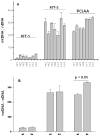DNA extraction procedures meaningfully influence qPCR-based mtDNA copy number determination
- PMID: 19324101
- PMCID: PMC2798162
- DOI: 10.1016/j.mito.2009.03.003
DNA extraction procedures meaningfully influence qPCR-based mtDNA copy number determination
Abstract
Quantitative real time PCR (qPCR) is commonly used to determine cell mitochondrial DNA (mtDNA) copy number. This technique involves obtaining the ratio of an unknown variable (number of copies of an mtDNA gene) to a known parameter (number of copies of a nuclear DNA gene) within a genomic DNA sample. We considered the possibility that mtDNA:nuclear DNA (nDNA) ratio determinations could vary depending on the method of genomic DNA extraction used, and that these differences could substantively impact mtDNA copy number determination via qPCR. To test this we measured mtDNA:nDNA ratios in genomic DNA samples prepared using organic solvent (phenol-chloroform-isoamyl alcohol) extraction and two different silica-based column methods, and found mtDNA:nDNA ratio estimates were not uniform. We further evaluated whether different genomic DNA preparation methods could influence outcomes of experiments that use mtDNA:nDNA ratios as endpoints, and found the method of genomic DNA extraction can indeed alter experimental outcomes. We conclude genomic DNA sample preparation can meaningfully influence mtDNA copy number determination by qPCR.
Figures




Similar articles
-
Using phiX174 DNA as an exogenous reference for measuring mitochondrial DNA copy number.Biotechniques. 2009 Oct;47(4):867-9. doi: 10.2144/000113222. Biotechniques. 2009. PMID: 19852770
-
Quantification of mitochondrial DNA copy number: pre-analytical factors.Mitochondrion. 2009 Jul;9(4):242-6. doi: 10.1016/j.mito.2009.02.006. Epub 2009 Mar 9. Mitochondrion. 2009. PMID: 19272467
-
Quality assessment of human mitochondrial DNA quantification: MITONAUTS, an international multicentre survey.Mitochondrion. 2011 May;11(3):520-7. doi: 10.1016/j.mito.2011.01.011. Epub 2011 Feb 22. Mitochondrion. 2011. PMID: 21303702 Free PMC article.
-
Analysis of mtDNA/nDNA Ratio in Mice.Curr Protoc Mouse Biol. 2017 Mar 2;7(1):47-54. doi: 10.1002/cpmo.21. Curr Protoc Mouse Biol. 2017. PMID: 28252199 Free PMC article.
-
Mitochondrial toxicity in the era of HAART: evaluating venous lactate and peripheral blood mitochondrial DNA in HIV-infected patients taking antiretroviral therapy.J Acquir Immune Defic Syndr. 2003 Sep;34 Suppl 1:S85-90. doi: 10.1097/00126334-200309011-00013. J Acquir Immune Defic Syndr. 2003. PMID: 14562863 Review.
Cited by
-
Metformin mitigates the impaired development of skeletal muscle in the offspring of obese mice.Nutr Diabetes. 2011 May 16;1(5):e7. doi: 10.1038/nutd.2011.3. Nutr Diabetes. 2011. PMID: 23449382 Free PMC article.
-
Mitochondrial DNA Manipulations Affect Tau Oligomerization.J Alzheimers Dis. 2020;77(1):149-163. doi: 10.3233/JAD-200286. J Alzheimers Dis. 2020. PMID: 32804126 Free PMC article.
-
Genomic analysis of a novel Aeromonas veronii phage pAEv1810, belonging to the genus Petsuvirus.Arch Microbiol. 2022 May 7;204(6):304. doi: 10.1007/s00203-022-02903-z. Arch Microbiol. 2022. PMID: 35524836
-
MitoQuicLy: a high-throughput method for quantifying cell-free DNA from human plasma, serum, and saliva.bioRxiv [Preprint]. 2023 Jan 4:2023.01.04.522744. doi: 10.1101/2023.01.04.522744. bioRxiv. 2023. Update in: Mitochondrion. 2023 Jul;71:26-39. doi: 10.1016/j.mito.2023.05.001. PMID: 36711938 Free PMC article. Updated. Preprint.
-
Humanin skeletal muscle protein levels increase after resistance training in men with impaired glucose metabolism.Physiol Rep. 2016 Dec;4(23):e13063. doi: 10.14814/phy2.13063. Physiol Rep. 2016. PMID: 27923980 Free PMC article. Clinical Trial.
References
-
- Aplenc R, Orudjev E, Swoyer J, Manke B, Rebbeck T. Differential bone marrow aspirate DNA yields from commercial extraction kits. Leukemia. 2002;16:1865–1866. - PubMed
-
- Bush C, Harvey M. Rapid isolation of genomic DNA from whole blood to borosilicate particles. Clin Chem. 1991;37:1060.
Publication types
MeSH terms
Substances
Grants and funding
LinkOut - more resources
Full Text Sources
Other Literature Sources

